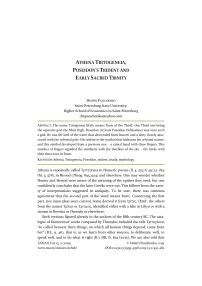Tritogeneia, Poseidon's trident and early sacred trinity
Автор: Panchenko Dmitri
Журнал: Schole. Философское антиковедение и классическая традиция @classics-nsu-schole
Рубрика: Статьи
Статья в выпуске: 2 т.13, 2019 года.
Бесплатный доступ
The name Tritogeneia likely means ‘born of the Third’, this Third one being the supreme god, the Most High. Poseidon (at least Poseidon Helikonios) was once such a god. He was the lord of the water that descended from heaven and a deity closely associated with the celestial pole. His trident is the symbol that indicates his celestial nature, and this symbol developed from a previous one - a raised hand with three fingers. This number of fingers signified the similarity with the dwellers of the sky - the birds, with their three toes in front.
Athena, tritogeneia, poseidon, trident, triads, mythology
Короткий адрес: https://sciup.org/147215823
IDR: 147215823 | DOI: 10.25205/1995-4328-2019-13-2-451-462
Список литературы Tritogeneia, Poseidon's trident and early sacred trinity
- https://nsu.ru/classics/schole/13/13-2-panchenko.pdf
- Blinkenberg, C. (1911) The Thunderweapon in Religion and Folklore. Cambridge: Cambridge University Press.
- Bunnens, G. (2004) "The Storm-God in Northern Syria and Southern Anatolia from Hadad of Aleppo to Jupiter Dolichenus", Ofizzielle Religion, locale Kulte und individuelle Religiosität hrsg. von M. Hutter und S. Hutter-Braunsar. Münster: Ugarit-Verlag, 57 - 81.
- Bouzek, J. (1985) The Aegean, Anatolia and Europe: Cultural Interrelations in the Second Millennium B. C. Praha: Academia.
- Bouzek, J. (1997) Greece, Anatolia and Europe: Cultural Interrelations during the Early Iron Age. Jonsered: P. Åström.
- Bradley, R. (2006) "Danish Razors and Swedish Rocks: Cosmology and the Bronze Age Landscape", Antiquity 80, 372-389.
- Burkert, W. (1985) Greek Religion. Cambridge, Mass.: Harvard University Press.
- Chantraine, P. (1968-1980) Dictionnaire étimologique de la langue grecque. Paris: Klincksieck.
- Cook, A. B. (1925) Zeus. A Study in Ancient Religion. Vol. II. Cambridge: Cambridge University Press.
- Cook, A. B. (1940) Zeus. A Study in Ancient Religion. Vol. III. Cambridge: Cambridge University Press.
- Dümmler (1896) "Athena", RE II, 1941-2020.
- Dynda, J. (2014) "The Three-Headed One at the Cross-Road: A Comparative Study of the Slavic God Triglav", Studia Mythologica Slavica XVII, 57-82.
- Frisk, H. (1960-1973) Griechisches etymologisches Wörterbuch. Bd. I-III. Heidelberg: Carl Winter.
- Farnell, L. R. (1907) The Cults of the Greek States. Vol. IV. Oxford: Clarendon Press.
- Faulkes, A., transl. and ed. (1996) Snorri Sturluson. Edda. London; Vermont.
- Fowler, M. (1947) "Trita Soter", Journal of the American Oriental Society 67 (1), 59-60.
- Gelling, P., Davidson, H. E. (1969) The Chariot of the Sun. London: Phoenix House.
- Golan, A (1993) Myth and Symbol. Moscow: Russlit (in Russian).
- Grimm, J. (1854) Deutsche Mythologie. Bd. I. 3. Aufl. Göttingen, Dietrische Buchhandlung.
- Gruppe, O. (1906) Griechische Mythologie und Religionsgeschichte. Bd. II. München, C. H. Beck.
- Hansen, W. (2004) Handbook of Classical Mythology. Santa Barbara, etc.: ABCCLIO.
- Herzfeld, E. E. (1941) Iran in the Ancient East. London; New York: Oxford University Press.
- Kirk, G. S. (1985). The Iliad: A Commentary. Vol. 1. Cambridge: Cambridge University Press.
- Kretschmer, P. (1919) "Mythische Namen", Glotta 10 (1/2), 38-62.
- Kristiansen, K. (2018) "The Winged Triad in Bronze Age Symbolism: Birds and Their Feet", Giving the Past a Future. Studies in Honour of Dr. Phil. h.c. Gerhard Milstreu, ed. by J. Dodd and E. Mejer. Oxford: Archaeopress, 70-74.
- Kruse (1939) "Tritogeneia", RE VII A 1, 244-245.
- Jessen (1912) "Helikonios", RE VIII, 9-11.
- Lease, E. B. (1919) "The Number Three, Mysterious, Mystic, Magic", Classical Philology 14 (1), 56-73.
- Lincoln, B. (1976) "The Indo-European Cattle-Raiding Myth", History of Religions 16 (1), 42-65.
- Lippold, G. (1911) "Τριτοπατρεῖς", Athenische Mitteilungen 36 (1) 105-109.
- Nilsson, M. P. (1967) Geschichte der griechischen Religion. Bd. I. München: C. H Beck.
- O'Neil, J. (1893-1897) The Nights of the Gods. An Inquiry into Cosmic and Cosmogonic Mythology and Symbolism. Vol. I - II. London: Harrison and Sons.
- Panchenko, D. (2016a) Homer, the Iliad and Troy. St Petersburg: European University at St Petersburg (in Russian).
- Panchenko, D. (2016b) "The Night Sky God of the European Bronze Age", Stratum plus 2, 255-264 (in Russian).
- Panchenko, D. (2010/2011) "Mice Destroying an Army (Hdt. 2. 141) and a Solution of the Tocharian Problem", Hyperboreus 16/17, 32-45.
- Panchenko, D. (2012) "Scandinavian Background of Greek Mythic Cosmography: The Sun's Water Transport", Hyperboreus 8 (1), 5-20.
- Robert, L. (1935) "Inscriptions de Lesbos et de Samos", Bulletin de correspondence hellénique 59, 471-488.
- Sprockhoff, E. (1955) "Das bronzene Zierband von Kronshagen bei Kiel", Offa 14, 5-120.
- Uckelmann, M. (2005) "Die Schilde von Herzsprung. Bemerkungen zu Herstellung, Funktion und Deutung", Jahresschrift für mitteldeutsche Vorgeschichte 89, 159-188.
- Usener, H. (1903) "Dreiheit", Rheinisches Museum 58, 1-47; 161-208; 321-362.
- Usener, H. (1905) "Keraunos", Rheinisches Museum 60, 1-30.
- Wærn, I. (1951) ΓΗΣ ΟΣΤΕΑ. The Kenning in Pre-Christian Greek Poetry. Uppsala: Almqvist and Wiksell.
- Walters, H. B. (1892-1893) "Poseidon's Trident", Journal of Hellenic Studies 13, 13-20.
- West, M. L., ed. (1966) Hesiod. Theogony. Oxford: Clarendon.
- West, M. L. (2007) Indo-European Poetry and Myth. Oxford: Oxford University Press.
- Wilamowitz-Moellendorff, U. von (1931) Der Glaube der Hellenen. Bd. I. Berlin: Weidmann.
- Zaicev, A. I. (2004) Greek Religion and Mythology. St Petersburg: St Petersburg State University, Department of Philology.


